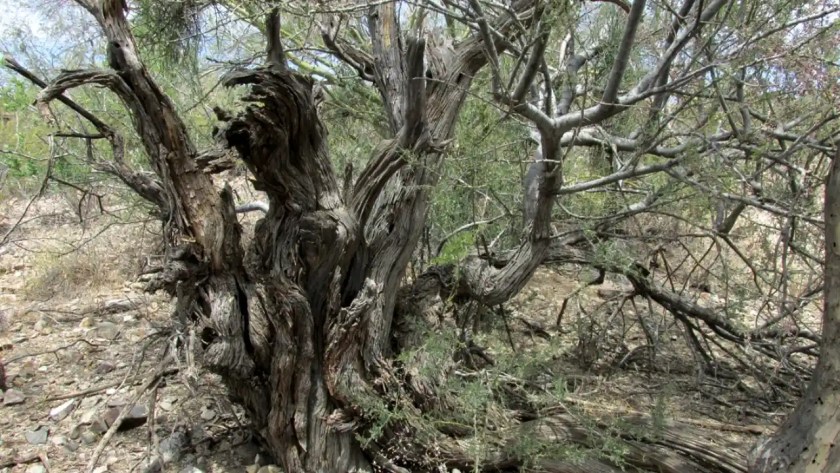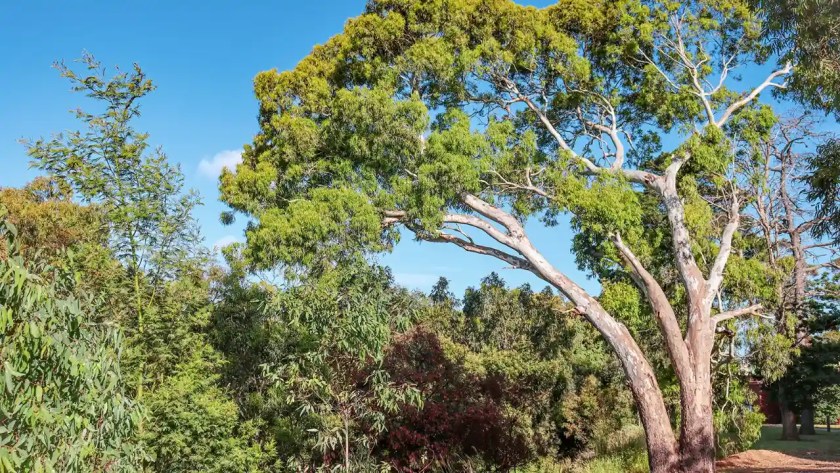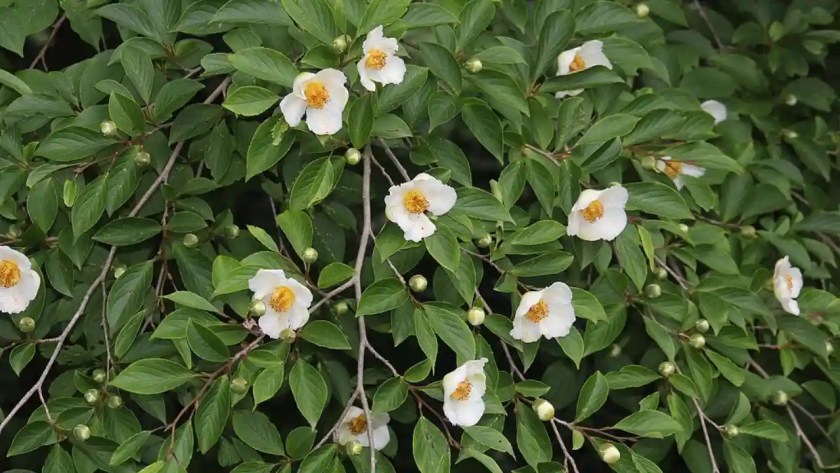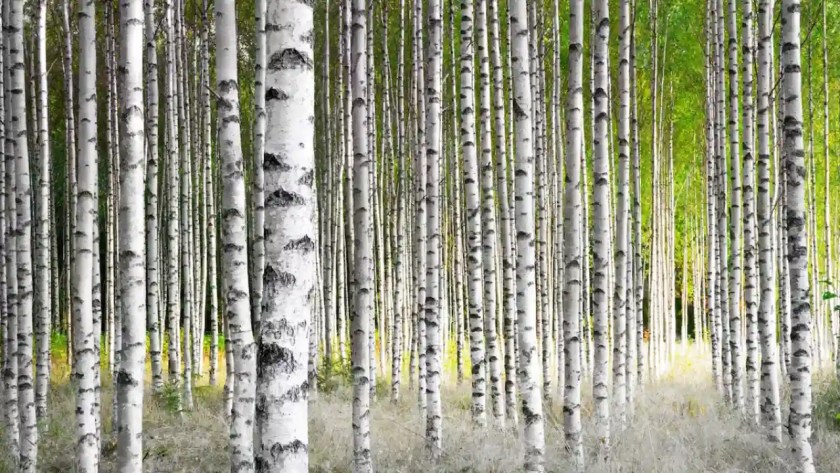The bark of a tree is one of the most important attributes it has. It serves to protect the tree from animal and weather damage and provides nutrients to the growing cells of the trunk.
However, not all bark is the same: some trees have thin, smooth bark, while others have thick, craggy bark that can be challenging for predators to penetrate.
Many trees do have smooth bark; birch and beech trees (which are some of the best trees to hang a swing from) for example, are smooth barked, but they are not alone in having smooth bark.
1. Desert Ironwood Trees

The signature feature of this tree is its shiny, smooth bark with a distinguished gray color.
The bark of these trees may develop broad cracks over its natural life span. But since Ironwood trees take a long time to develop, it will stay mostly smooth for the length of its life.
The wood is dense and hard, which is why it earns the name “Ironwood”. They do grow in hot and dry habitats (like deserts), and although the bark is a pale grey they actually provide contrast against a number of other trees.
As Desert Ironwood trees grow, their bark cracks give them a fissured appearance, but keep in mind, they can live as long as 1600 years.
Like many trees, the outer portion of its bark is dead, so it grows cracks over time, but there can be other causes; such as the desert environment, insects, or the dry wind.
Take a Closer Look – When looking at dead trees, you can tell it is old because the color of the bark has been ever so slightly colored with brown along with the pale gray.
2. Eucalyptus Trees

The Eucalyptus tree is an extremely diverse type of tree.
While many trees exhibit a smooth to somewhat smooth bark, there is a wide range of texture and color within the Eucalyptus species’ bark compared to other trees within that same category.
Unlike most other trees in general, members of the Eucalyptus family do not have fissures in their bark. This is because they shed their old, dry, bark in favor of new, smooth, bark.
This process is called exfoliating bark, a tree would naturally shed its bark like this in order to allow more light and transpiration – a process that which increases the longevity of the tree.
One of the more exciting types of bark is Eucalyptus deglupta.
This tree is know for being one of the few types of multi-colored bark trees, and you might have heard its other name – Rainbow Eucalyptus.
Eucalyptus deglupta has a very distinct color, shades of green, brown, red, and lavender is all over the length of the tree.
In general, a Eucalyptus tree is very difficult to identify correctly, simply because most of them are actually quite similarity in comparison to one another but also quite different in that resemblance can make identifying them difficult.
A better way to identify them would be by texture. The bark is so flaky to the touch.
3. Sycamore Trees

Sycamore trees start out with very smooth bark in their first stage of life and come in a couple of attractive colors.
They have bark that is white, brown, gray, and sometimes tan. But this varies a lot based on where the tree is located.
Mexican sycamores are smaller trees with very smooth white bark and light brown streaks.
The peeling and exfoliation comes off a little bit differently with Mexican sycamores than with American sycamores, mainly in a patchwork fashion.
In Arizona, the sycamores have gray bark which peels away in flakes to reveal smooth milky white bark underneath, distinguishing them from the overall family of sycamores.
Sycamores, along with their bark, are easy to identify because of their overall trunk shape and because of the peeling bark.
Due to the mixing of all of the colors which causes a camouflage-type look, the bark has a completely unique look with a jigsaw-puzzle type look to the exfoliating bark.
Sycamores are also just outright exfoliating trees.
If you have a moment to spare, make sure to look at a tree that is peeling to reveal a smooth surface underneath, as that would most likely be a member of the sycamore tree family.
4. Red Maple trees

Red maple trees have smooth bark and an ashen color, sometimes with the bark being silver
As the tree matures, the bark changes. The texture changes, and older Red Maple bark gets darker with time. The texture loses it’s smoothness and older trees look rough as well because of the cracks.
This bark gets splayed apart into plates and because of this, you can spot an old red-maple tree easily. The bark color will often fade from the bottom as well.
You can recognize red maple trees by the gray light and furrowed bark, which are all recognizable.
If you see a darker color and there are some cracks showing through the color at the bottom of the tree that means the tree is maturing.
5. Japanese Stewartia

Not many trees have peelable bark that features a variety of bark colors.
That is what makes Japanese Stewartia one of the most beautiful trees in the large smooth bark category.
The bark can be grey, reddish brown, orange or cinnamon.
The inner bark surface is smooth, and the trees will keep it that way through regular exfoliation.
The way Stewartia combines its desirable colors and contrast is what makes it bark especially pronounced in a winter landscape.
You can quickly find Stewartia trees during the winter when you check to see if the bark has a combination of these colors and if the area of the tree where the outer bark has peeled off has a smooth surface.
6. Beech Trees

The most captivating aspect of beech trees and their bark is that the surface stays smooth through maturity. That, and it has a light silver-gray color.
The texture has etchings that protrude horizontally, but some trees have ripples that also travel vertically, up the bark.
There are no solid reasons for having ripples, however, some may think that stress on the tree causes some patterns to change.
The bark of this tree is a thin covering and makes it easy to identify. Often, you can distinguish a beech tree simply by its etched, silvery bark.
If You’re Unsure – Look for ripples in the texture on the edge of the tree.
7. Birch Trees

The bark of Birch trees is smooth when they first start growing, but as the tree grows older, deep ridges develop on its surface creating a rough bark.
Birch trees are often recognized by their habit of shredding all of their bark off the tree in long single strips in a horizontal manner while revealing colors of yellow, silver, black, or gray in the bark.
When observing a Birch tree, it is important to remember that the tree’s bark is a common source of food for rabbits, deer, and birds.
Many people may confuse the teeth marks of an animal as a pattern, and as with finding the horizontal threads or strips across the bark of a Birch tree, it can be easy to confuse it with animal bites; therefore, it is important to remember that their bark is a common source of food for animals when observing the tree.
Uses of Bark
Tree barks are utilized in a range of areas.
If you are able to identify the right species, there can be a positive return on your investment!
Here is a small handful of ways you can use smooth tree barks.
Medicinal

Birch trees are renowned for not just for their bark as a medicinal resource, but also for their bark containing betulinic acid which is often used in pharmaceutical preparations.
One more notable fact regarding birch tree bark is it can also be steeped in boiling water and casted around the arm, betulin can also be extracted from the birch tree and used for pain or analgescii properties.
Sycamore tree bark can also be steeped in boiling water and made into a tea for the treatment of coughs and colds or even tuberculosis. It is also known to have various laxative type effects.
Desert ironwood tree bark can serve as an emetic to assist with vomiting.
The flowers from a tree may serve the same purpose for inflammatory conditions, as well as formulations for hemorrhoids.
Red maple bark has also been used for its analgesic properties as well and has been used in treatment of eye cataracts. The tea brewed from the bark may also assist with diarrhea.
Beech tree bark has various uses, such as:
- being an antiseptic
- a stimulant
- and a viable option for treating skin diseases
Crafting
Additionally, these trees’ bark has been fashioned into many items.
Smooth bark often provides baskets, home décor items, hair clips, and other products of excellent guality.
As an example, Iron Wood is one of the heaviest woods in the world and is often used in buildings and is regularly used for firewood.
Final Thoughts
There are smooth bark trees found worldwide.
They’re great for versatility and have different uses as the names suggest.
Having a smooth bark tree has been utilized in various ways from people around the world and we still do.
The smooth bark tree is a valuable and unique tree providing extensive benefits for those that know how to utilize the unique properties of the tree.
Now that you have a list of smooth bark trees try to see for yourself the next time your out hiking!